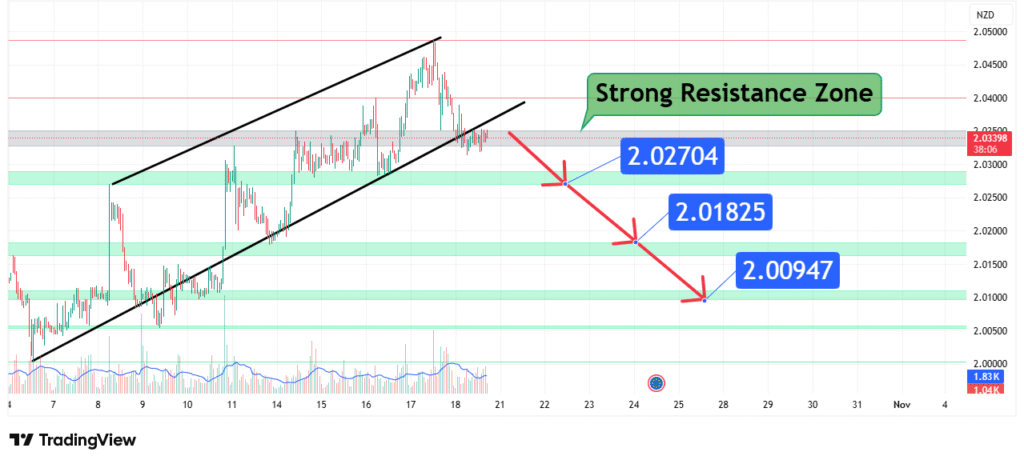
EURNZD Bearish Setup Targeting 2.027, 2.018, and 2.00
EURNZD’s price has rallied strongly and is now testing a significant Strong Resistance Zone between 2.00947 and 2.02704. This price action suggests buyer exhaustion and a bearish reversal bias is forming. Our analysis projects a rejection from this zone and a subsequent decline towards a primary target of 2.018, with further targets at 2.027 (as a first stop) and 2.00. This prediction is based on a confluence of technical factors, primarily the presence of a multi-layered resistance zone that has historically capped upward moves.
Current Market Structure and Price Action
The current market structure is bullish in the short term, characterized by a clear rally that has brought the price to a critical ceiling. The price is currently interacting with a dense and strong resistance zone. Recent price action, showing a slowdown in upward momentum as it enters this zone, indicates that a bearish reversal or a significant pullback may be imminent. The current price of ~2.033 is sitting within the upper bounds of this resistance, increasing the probability of a rejection.
Identification of the Key Resistance Zone
The most critical technical element is the Strong Resistance Zone between approximately 2.00947 and 2.02704. The strength of this zone is derived from:
- Historical Significance: This level has acted as a major swing high and consolidation area on multiple previous occasions, as marked on the chart. Each touch has resulted in a noticeable bearish reaction, establishing it as a key technical barrier.
- Technical Confluence: The zone is not a single line but a band, comprising at least three distinct resistance levels (2.00947, 2.01825, 2.02704). This multi-layered structure makes it a formidable obstacle for bulls.
- Market Psychology: This area represents a point where sellers have historically become active and buyers who entered at lower levels may look to take profits, creating a supply overhang.
This confluence makes it a high-probability level for a strong bearish reaction.
Technical Target(s) and Rationale
Our analysis identifies the following price targets for a bearish move:
Initial Target (PT1): 2.027
This is the first line of defense within the resistance zone. A pullback could find temporary support here before a deeper decline. It acts as an initial profit-taking level.
Primary Target (PT2): 2.018
This level represents a more significant support and the midpoint of the resistance zone. A break below 2.027 would likely target this level, which also aligns with a previous swing high, now acting as support.
Secondary Target (PT3): 2.00
This is a key psychological and technical round number. It represents a more ambitious target, likely corresponding with a larger degree support zone or a Fibonacci retracement level (e.g., the 50% or 61.8% retracement of the recent rally).

Prediction: We forecast that the price will face rejection from the Strong Resistance Zone and move downwards, first towards 2.027, then to our primary target at 2.018. A sustained bearish momentum could then extend the move towards the psychological target of 2.00.
Risk Management Considerations
A professional strategy is defined by its risk management.
- Invalidation Level (Stop-Loss): The entire bearish thesis is invalidated if the price achieves a sustained daily close above the top of the resistance zone, specifically above 2.03000. A break and close above this level would indicate a decisive bullish breakout, negating the reversal setup and likely triggering a move higher.
- Position Sizing: Any short positions taken should be sized so that a loss triggered at the invalidation level represents a small, pre-defined percentage of your total capital (e.g., 1-2%).
Fundamental Backdrop
The technical setup is framed by the current fundamental landscape:
- Reserve Bank of New Zealand (RBNZ) Hawkish Stance: The RBNZ has maintained a relatively hawkish outlook, which could provide underlying strength to the NZD and act as a headwind for EURNZD.
- European Central Bank (ECB) Uncertainty: The ECB faces a delicate balancing act between high inflation and slowing economic growth in the Eurozone. Any dovish signals could weaken the Euro.
- Commodity Market Influence: As a commodity-linked currency, the NZD is sensitive to global risk sentiment and commodity prices (especially dairy). A rebound in risk appetite could benefit the NZD.
These factors contribute to the cautious or bearish sentiment surrounding the EURNZD pair at these elevated levels.
Conclusion
EURNZD is at a critical technical inflection point, testing a multi-layered resistance zone. The weight of evidence suggests a bearish resolution, projecting a decline towards 2.018 and potentially 2.00. Traders should monitor for clear rejection signals (e.g., bearish pin bars or engulfing patterns) at this resistance and manage risk diligently by respecting the key invalidation level above 2.03000. The reaction at the initial target of 2.027 will be key for assessing the strength of the bearish momentum.
Chart Source: TradingView
Disclaimer: This analysis is for informational and educational purposes only and does not constitute financial advice or a recommendation to buy or sell any security. All trading and investing involves significant risk, including the possible loss of your entire investment. Always conduct your own research (DYOR) and consider seeking advice from an independent financial professional before making any trading decisions.






